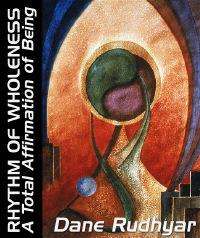 |
| Home | Bio | Art | Music | Literature | Civilization & Culture | Philosophy of Wholeness | Theosophy & Spirituality | Astrology |

RHYTHM OF WHOLENESS A Total Affirmation of Being by Dane Rudhyar, 1983 CONTENTS PROLOGUE PART ONE The Philosophy of Operative Wholeness 1. Prelude to a New Interpretation of Reality 2. The Search for Spiritual Security: The One, the Whole, and Wholeness 3. The Movement of Wholeness Page 1 Page 2 Page 3 Page 4 Page 5 PART TWO The Cycle of Being 4. The Structure of the Cycle of Being 5. The Four Crucial Phases of the Cycle of Being 6. The Inevitability of Success and Failure 7. Spirit and Mind PART THREE The Cycle of Man 8. Constitution of Man - The Physical and Psychic Bodies 9. Constitution of Man - The Spiritual Entity and the Higher Mind 10. The Structure and Transformation of the Total Person 11. The Cyclic Process of Spiritual Embodiment PART FOUR In The Spirit of Wholeness 12. The Principle of Holarchy and the Interplay of Horizontal and Vertical Relationships 13. Transpersonal Activity versus Mediumship 14. Rites of Passage EPILOGUE |

CHAPTER THREE
The Movement of Wholeness - 5 Thus the Movement of Wholeness as the cycle of being is the foundation of a commonsense approach to being — to the very fact of existing — which must be accepted now that the basic issue facing mankind is the global integration of all human beings within a truly planetary sense of community. This requires a structure of organization broad enough to find a place, value, and meaning for all manifestations of human consciousness. Mankind needs an all-inclusive frame of reference, a total affirmation of being. For we must think not only of the trend toward Unity and thereby negate, violently oppose, and try to exorcise the still powerful principle of Multiplicity. Instead, we have to develop an all-inclusive consciousness that can deal intelligently with all components of personhood — a consciousness of operative Wholeness. This consciousness will be free from the particularity of only a moment of time, a fugitive now, because it has experienced and constantly retains the memory of the Wholeness of the cycle of being. Such an ideal and truly holistic human memory retains the experiences of the Night period as well as those of the Day; it remembers what comes between the small sub-cycles of embodied personal existence, just as during the embodied cycle it is fully aware of the transitions between waking consciousness and sleep. Through powerful experiences of Wholeness, the person, aware of the totality of the spectrum of its being, actually becomes Wholeness in operation. Even though the person is but a brief moment in the cosmic cycle of being, the consciousness identified with Wholeness can accept not only all that came before that moment and all that will follow; it can also accept the Whole in a total affirmation of all-inclusive being. It experiences what "is" in terms of the cyclic wholeness of the Whole, thus sub specie aeternitatis — the true meaning of eternity (before it was perverted by the early fathers of the Church) being the Wholeness of a cyclic movement (an Eon). In this realization, even if it is only mental, there can be inner security and peace. Such security is not apart from the changes and tensions implied in the state of existence, but lies in the incontrovertible realization of the dynamic harmony of opposites operating in the Whole. Neither Unity nor Multiplicity is emphasized, neither the subjective "I" nor the objectivity of the complex relationships that fill the state of embodied existence. Peace is poised in their unceasing interplay — established in Wholeness. An individualized person can, however, resist the unceasing, driving force of the Movement of Wholeness. He or she can cling to the particular form his or her selfhood has taken — because the form is pleasurable and beautiful or because the ego is afraid of being unable to cope with the change. The individual seeks to immortalize moments of fulfillment or even in some cases a familiar pain with which the ego has become identified. All negations arise out of fear. To overcome this fear, to allow the flow of the Movement of Wholeness to move one's entire being, even though the mind can not yet picture the "where to": this is the constant challenge facing the individualized, self-conscious person. Such a challenge can be met more readily if the mind understands where the individual stands in the vast cycle of being — not only where he or she stands as an individual, but where humanity as a whole and his or her culture stand. Knowing where one stands not only illumines the path just ahead; it also helps one understand how this position has been reached and therefore how the fear of change can be overcome most logically and consistently. To willingly and affirmatively accept one's position in the largest whole to which one can deeply feel one belongs, to allow the power of the Movement of Wholeness to drive one step by step — this is the meaning of spiritual living. No step can be missed, however difficult it may seem. Every step is inherently difficult because it means renouncing a lesser form of stability in order to gain a greater realization of Wholeness. In the process, an experience of instability must be met — with courage as well as faith. Probably the majority of human beings need to believe in a personal God to sustain such a faith. God is the divine Father or Mother for whoever still functions mainly at the biological level of wholeness and consciousness. For the person whose relative sense of isolation seeks solace, God is the supreme and utterly dependable "Thou" to Whom the distraught "I" may turn for reassurance and inner strength. If a conscious and autonomous individual can respond to the idea of a total affirmation of being throughout the vast cyclic process of the Movement of Wholeness — is able to experience Wholeness as a dynamic Presence in all there is and can ever be — the realization that one belongs to a far-reaching greater Whole in whose field of existence one lives, moves, and has one's being can be a profoundly sustaining as well as enlightening factor in the inner life. In that greater Whole the individuals who see themselves also as individualized wholes — lesser wholes — can accept their function "in the Name of" Wholeness. The individual is Wholeness operating within a definite, and therefore finite, field of activity and consciousness. The individual is his or her dharma or position and function within the greater whole; but he or she is also Wholeness operating in and through this particular position or stage of the great cycle of being. The individual is not only an efficient performer of a definite (thus finite) role in the field of activity of the greater whole; in and through the individual as performer, Wholeness (or "beingness") is affirming itself in a particular mode. To the conscious and enlightened performer, the performance is but one fleeting phase in the cyclic Movement of Wholeness. He or she is that phase, yet more than that phase because the all-inclusive reality of being is the rhythmic Movement — and the performer is aware of this. The performer is the moving, and in and through the performance, the performing. To use a musical metaphor, the person is not only a bassoonist playing a C-sharp written in the score of a symphony, but also "Music" being performed in terms of the culture's approach to it. This cultural approach, in turn, represents one of the many ways in which "Music" cyclically makes use of sounds. In the great Movement of being, every performer is Wholeness in act. The human mind that has passed through the process of individualization and has learned to play its part should experience itself performing in the symphonic wholeness of the most inclusive whole in which it is able to effectively participate. It may progress from a small instrumental group in a college to a large metropolitan orchestra. But whether the orchestra is small and part of a learning situation or a magnificent organization of perfect performers, "Music" can still be experienced and realized in the performing. Each tone may be produced "in the Name of" Music. Every human life likewise can be lived "in the Name of" Wholeness. It can be Wholeness in act, operative Wholeness.(2) To be thus established in Wholeness requires a lucid understanding of the two principles that operate in the Whole — in any whole. It requires an inclusive realization of the forces interacting throughout the cyclic Movement of Wholeness, so that as human beings we can properly evaluate our place within this Movement. Through such an evaluation we can then understand the part in the vast process of being we are called upon to play, according to the time and place of our existence. In such an understanding the individual comes to know and to accept his or her dharma or "truth of being." And in the fulfillment of this dharma, Wholeness reveals itself to itself through the individual's whole being. In this revelation there is, indeed, security and peace. 2. One may relate such an approach to life to the Hindu concept of karma yoga in its most inclusive aspect. Jnana yoga, on the other hand refers to the attitude promoted by the "contemplative tradition" particularly dominant in Hinayana Buddhism and Zen. This tradition stresses meditation as the one means of reaching an increasingly subjective state of consciousness. In its extreme form, such an approach leads to the "paralyzing" of the bio-psychic and mental instrumentalities of perception, feeling, and cogitating — thus of the means of contact with and response to the world of objectivity and multiplicity. The ideal result is the attainment of samadhi or nirvana. At the level of universal being, this is a state approaching that of the Godhead. Yet it is not an "absolute" state. A third approach is bhakti yoga, the path of devotion to a relatively or absolutely supreme person, a "self-realized" guru or Lord God Himself. The drive toward a state of unity which is as complete as possible takes the form of total identification with an intensely unified center of consciousness, or rather, it takes the form of quasi-total absorption into the circle (mandala) controlled and integrated by the power and will of this center. These three basic approaches may to some extent be blended, yet one of them normally prevails. Return By permission of Leyla Rudhyar Hill Copyright © 1983 by Dane Rudhyar All Rights Reserved.  Web design and all data, text and graphics appearing on this site are protected by US and International Copyright and are not to be reproduced, distributed, circulated, offered for sale, or given away, in any form, by any means, electronic or conventional. See Notices for full copyright statement and conditions of use. Web design copyright © 2000-2004 by Michael R. Meyer. All Rights Reserved. |
 |